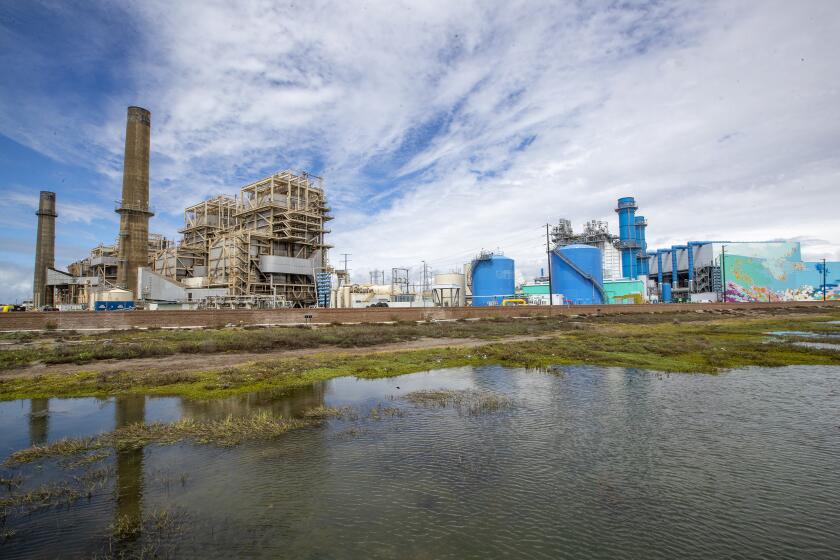Do investment fund pledges to cut emissions really add up?
- Share via
As global warming leaves a trail of wildfires, drought and human loss across much of the Northern Hemisphere, there’s fresh evidence that the financial pledges needed to protect the environment may not be fit for purpose.
“I hope that what we’re seeing will accelerate action, but it’s not necessarily the case,” said Jean-Xavier Hecker, co-head of ESG research at JPMorgan Chase & Co., in an interview.
Commitments to slash greenhouse gas emissions by the world’s biggest asset managers are at best inconsistent, with analysts at Morningstar Inc. and JPMorgan seeing significant differences in how firms like Vanguard Group and State Street Corp. explain their net-zero emissions goals. But with the latest bout of extreme weather underscoring the need for urgent action, there’s little time for the finance industry to experiment with different models for calculating their carbon footprint.
Gov. Gavin Newsom is struggling to keep the lights on while fighting climate change.
“The longer we spend talking about methodologies and data, the longer we delay action,” said Hortense Bioy, global head of sustainability research at Morningstar Inc., which is calling for greater standardization of net-zero methods. “The window of opportunity to take any meaningful climate action is rapidly closing.”
Some of the biggest fund managers remain heavily invested in the fossil-fuel industry. According to analysts at Bank of America Corp., European-based ESG equity funds have been increasing their holdings of energy companies such as Shell Plc, Repsol SA and Aker BP ASA in recent months. While many asset managers have yet to align the bulk of their assets with carbon-neutrality goals, some large investment firms have adopted varied net-zero strategies, making it hard to compare results and measure real-world impact.
The Net Zero Asset Managers initiative, which represents firms with $61 trillion of assets, allows members to choose between three methods for calculating how much of their portfolios are aligned with a net-zero goal. The thinking is that managers need flexibility to accommodate different operating models.
The result is a patchwork of outcomes. Axa Investment Managers has committed 65% of its assets to net zero and set a carbon intensity target — a measure of emissions relative to revenue — of 50% by 2030. BlackRock Inc., the world’s biggest money manager, uses a different gauge and says it expects “at least” 75% of corporate and sovereign assets to be invested “in issuers with science-based targets or equivalent” by the end of the decade, according to an NZAM report in May.
“BlackRock’s formulation stands out because it’s not a pure commitment but more of an expectation” for achieving net zero, said Hugo Dubourg, co-head of ESG research at JPMorgan. It relies mainly on BlackRock’s investee companies hitting their targets first.
NZAM members are also free to decide how much of their portfolios to commit to climate neutrality goals. That means they can exclude high-polluting industries.
“For this reason, membership of the initiative alone shouldn’t be interpreted as proof of a credible pledge,” said Katie Stewart, senior research officer at ShareAction, in an email.
NZAM said in an email that its approach acknowledges the finance industry needs time to adapt. “These initial targets are just the asset managers’ individual starting points,” the group said. NZAM’s plan is to offer more guidance on how to report, particularly on private equity, derivatives, infrastructure assets and index-linked products.
On paper, BlackRock is way ahead of State Street and Vanguard, with 77% of its assets closely aligned to its net-zero goal. That compares with 14% of assets for State Street and 4% for Vanguard, according to NZAM data.
The difference for the three firms that are best known for their index-tracking funds lies in their net-zero methodologies. “It doesn’t make — at the outset — any intuitive sense,” said Carlo Funk, an ESG investment strategy head at State Street, in an interview.
State Street’s goal of hitting net zero by 2030 rests on its ability to cut financed Scope 1 emissions intensity (from direct operations) and Scope 2 emissions intensity (from purchased energy) by half, with cuts to Scope 3 emissions intensity (linked to the broader value chain) to be phased in later.
BlackRock’s net-zero goal for 2030, meanwhile, is based on how its investee companies are expected to perform, namely the share that have set science-based targets themselves. BlackRock declined to comment. In previous statements, it has stated that clients with investments worth $3.3 trillion have already made net-zero commitments, which will help BlackRock achieve its own net-zero goal.
Vanguard, for its part, limits the scope of its net-zero ambitions to actively managed funds. It aims for at least half the funds’ market value to come from companies that target net zero. Vanguard chose that approach to ensure targets are accountable over the long term, according to a company spokesman.
Bloomberg writer Anchalee Worrachate contributed to this report.
More to Read
Inside the business of entertainment
The Wide Shot brings you news, analysis and insights on everything from streaming wars to production — and what it all means for the future.
You may occasionally receive promotional content from the Los Angeles Times.











